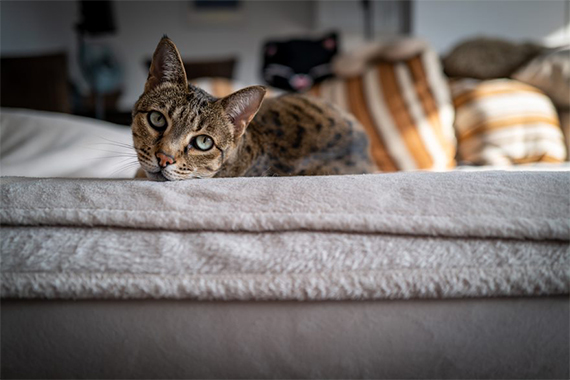Savannah Cat
The Savannah is a rare cat breed. The still fairly young breed originated from a cross between a Serval and a house cat. Hence its impressive, exotic appearance. The Savannah is very social: he is friendly towards children, cats and dogs. The gentle cat likes to be around people and loves its owner. The playful and curious Savannah is anything but an indoor cat and therefore needs a lot of space and exercise.

Characteristics
Character
There are different types of Savannahs. This has to do with which generation the Savannah comes from; F1 is from the first generation, F2 from the second generation and so on. Often, F1 and F2 Savannahs are larger than generations that come after. This is because the genetic influence of the African serval is much bigger in the first generations. The Savannah is more social than the ‘normal’ house cat. He gets along with people, children, other cats and dogs (only if he is well socialised). This loyal cat breed has a strong bond with its owner and will follow him anywhere. The curious Savannah is very intelligent and therefore easy to train. This obedient cat will learn to walk with a harness on in no time; that’s why he gets compared to a dog! This dog-like behaviour is also reflected in the way the Savannah plays: he can entertain himself for hours with games of fetch. The Savannah also loves water, unlike most other cats. Savannahs should not be kept in a flat as indoor cats; this hunter needs a lot of space and exercise. This cat is also a good jumper and can reach heights up to 2.5 metres! Legally, the Savannah falls under the Serval. It is considered a wild animal, which means that you cannot let it run free. If you want to leave your Savannah outside, you will need to get an outdoor enclosure or cage. This breed is a slow grower and does not reach its full height and weight until it is three years old. The coat care is fairly simple.
Physical Characteristics
Colour
The Savannah has a brown, silver, black or smoke coat colour with a black or brown mottled pattern. A dark colour pattern runs over the body. It is a series of parallel stripes, running from the back of the head to just over the shoulder. There could be some stripes on the back as well. Smaller spots can be found on the legs and feet as well as on the face.
Body, legs and tailt
The body of the Savannah is large, slender, and elegant. He has a proud attitude. In general, males are bigger than females. Its size is sometimes exaggerated, but in reality, the breed is usually a little larger than the average house cat. Because the Savannah stands very high on his legs, they can seem quite large. The hind legs are slightly longer than the front legs. The muscles are powerful and the cat is good at jumping. The tail of the Savannah is of medium length and has black rings with a solid, black end.
Head, ears and eyes
Compared to the body, the head of the Savannah is small. The head is longer than broad and stands on a slender, long neck. The front of the face should have a clear, symmetrical, triangular shape. The Savannah has a long and somewhat appearing swollen nose. The chin is small. Its sonar-like ears are very large and placed high on the head. The tips of the ears are rounded. On the back of the ears, there should be stripes. The eyes of the Savannah have a remarkable shape. The top of the eye is triangular, while the bottom is more almond-shaped. The eyes are slightly slanted. The eyes are somewhat ‘sunken’, which protects this cat against bright sunlight. From the corner of the eye, there are so-called black “cheetah tears” running down the sides of the nose and then to the whiskers. All eye colours are allowed and should be in harmony with the coat colour.
Coat
Savannahs have a short-haired, dense coat that can have a coarse or soft texture.



